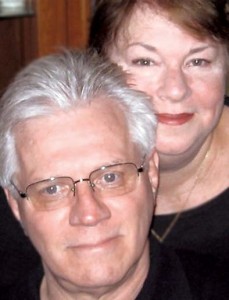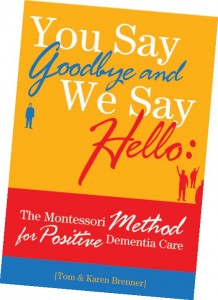A new book aims to help dementia caregivers connect with their loved ones—in sometimes surprising ways.
By Sam Gaines
Caregiving for a person with dementia or Alzheimer’s disease can be fraught with frustration, but it also can be rewarding in ways that may surprise a caregiver. Getting to those rewarding moments is the subject of You Say Goodbye and We Say Hello, a new book by husband-and-wife team Tom and Karen Brenner. The Brenners—

Tom is a gerontologist, trainer, and researcher in the caregiving field, while Karen is an experienced Montessori educator who now works with Tom on Brenner Pathways, the couple’s business—have been featured speakers at conferences on aging for years.
In fact, the book emerged from a frequent request the couple heard at the conferences where they spoke. “Often at these talks, people would come up to ask, ‘Where can we buy your book?’” says Karen. “A few years ago, one of the attendees asked us, ‘Don’t you think you owe it to the aging community to write a book?’ So we were encouraged to write it down.”
What they wrote down is a wealth of real-world experiences where they have been able to reach dementia patients by applying Montessori methods to their work. The Montessori Method refers to the work and philosophy of Maria Montessori, an Italian physician and educator from the late 19th and early to mid-20th centuries whose pioneering work with disadvantaged children opened the door to a more humane, compassionate approach to childhood education. Montessori developed the use of child-sized furniture and child-appropriate educational materials to reach children previously thought unreachable, and her philosophy embraced the encouragement of self-discipline and self-inspired achievement. The results were so successful that her methods have been used around the world in all types of schools (including Montessori schools) to help children succeed in learning.
In their many years of experience working with elder-care facilities and memory enhancement centers, the Brenners came to see that applying Montessori methods could achieve breakthroughs with people with dementia, as well. “Through it all, Karen and I believe that one of the fundamental aspects of this process is that learning never ends,” says Tom. “To a lot of people who have worked in the dementia field, it is an earth-shattering concept when you give them the news that people with dementia can still learn.”
 And learn they do. Throughout You Say Goodbye and We Say Hello, the Brenners document astounding instances in which using or adapting a Montessori tool led to a moment of real connection with a person with dementia or Alzheimer’s. In one case, Tom and Karen encountered a man who had been a farmer and who had advanced dementia. He and his brother had both been placed in the memory enhancement center and they could no longer handle farming duties. “So I was thinking, how can I engage people who have this interest?” Tom recalls. He obtained some tractor pictures, had them laminated, and simply asked the gentleman, “Would you like to look at some tractors with me?” The man agreed. They came upon one picture that showed the tractor in high grass. Tom said it looked broken, but the man gently corrected him. “‘Young man, listen: That tractor ain’t broken. It’s just been parked in high grass. Sometimes you have to look deeper.’ Truly, that has become a core principle of our work.”
And learn they do. Throughout You Say Goodbye and We Say Hello, the Brenners document astounding instances in which using or adapting a Montessori tool led to a moment of real connection with a person with dementia or Alzheimer’s. In one case, Tom and Karen encountered a man who had been a farmer and who had advanced dementia. He and his brother had both been placed in the memory enhancement center and they could no longer handle farming duties. “So I was thinking, how can I engage people who have this interest?” Tom recalls. He obtained some tractor pictures, had them laminated, and simply asked the gentleman, “Would you like to look at some tractors with me?” The man agreed. They came upon one picture that showed the tractor in high grass. Tom said it looked broken, but the man gently corrected him. “‘Young man, listen: That tractor ain’t broken. It’s just been parked in high grass. Sometimes you have to look deeper.’ Truly, that has become a core principle of our work.”
Another core principle of the Brenners’ work and the book is to meet people where they are, without expectations. “People with dementia are not the walking dead, being in a relationship with someone who happens to have this condition is not just one long goodbye,” the Brenners write. “We have to find a new way to say hello; it is our job to find a way to be in relationships.” Part of that process is using positive language in talking with caregivers and people with dementia. “We believe that being a caregiver is an opportunity to be more than we thought we could be,” says Tom. “We fully realize how demanding, exhausting, and heartbreaking this work can be. However, if we can get caregivers to think in a more positive way about the work they’re doing, this can transform their caregiving role and how they feel about what they do.”
Another key point the Brenners make in the book is the importance of what is called “procedural memory,” or “muscle memory,” in connecting with people with dementia. This can be seen when a natural object is placed in the hands of a person with dementia. In one instance, Tom brought some old hubcaps with him to a center, where he invited one man to polish hubcaps with him (using non-toxic polish). “This guy starts telling me war stories from Vietnam, like he’s sitting [on] the footlocker in the barracks, talking to another GI—he’s back polishing his boots, or his brass, and we’re talking war stories. I was really astonished!”
Storytelling (as well as reciting poetry and sharing jokes) is another important piece of the Brenners’ work, as they outline in the book. “Moments when patients are sharing their stories are moments when they are present with us. These moments, no matter how brief or how fleeting, can be times of great meaning and wonderful, deeply felt connection,” the Brenners write. “It is these moments of soul-to-soul connection that are captured in the stories that people tell us. It is through these stories that the spirit of the people we meet in our work comes shining through the fog of dementia.”
You Say Goodbye and We Say Hello is an inspiring, eye-opening look into how using The Montessori Method and creating a positive environment can deepen the connection between caregivers and the people they love.
You Say Goodbye and We Say Hello is available through Amazon.com and as an iBook through the Apple Store.










